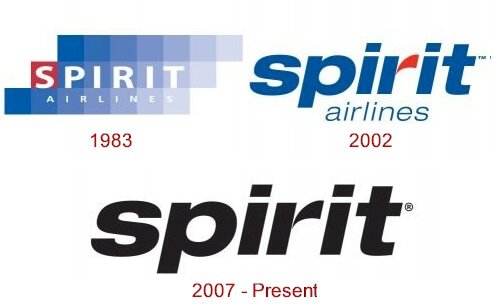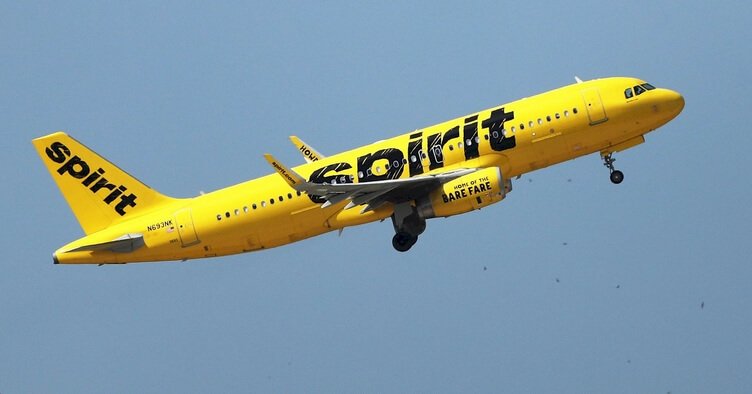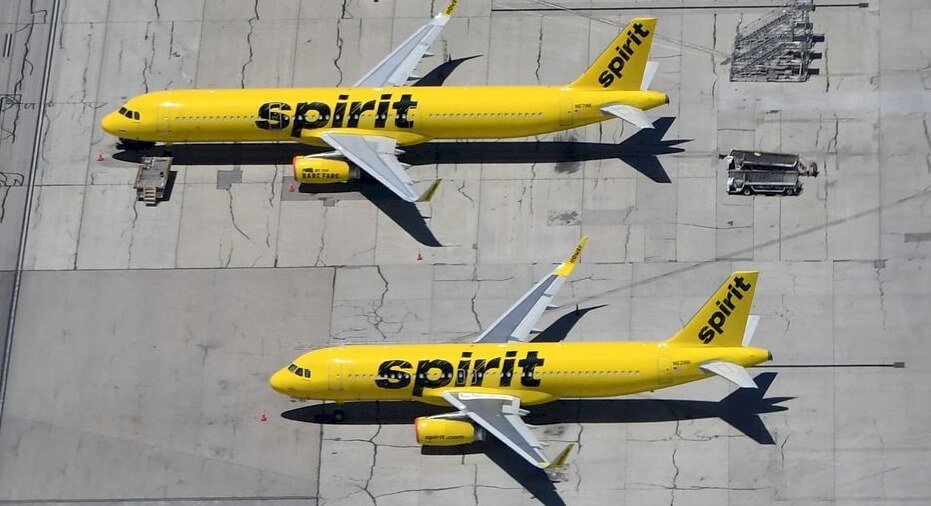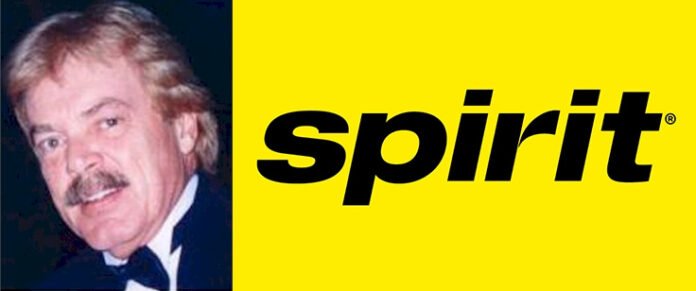Let’s get an insight into the Spirit Airlines logo and some history behind the low-cost carrier.
In 1983, Ned Homfeld spotted a need among casino gamblers. So, to satisfy this unique gap, he began an active tour service in Macomb County, Michigan. He named it Charter One, flying to entertainment centers like Atlantic City, Las Vegas, and the Bahamas.
After serving tourists for about ten years, the company changed its name to Spirit Airlines. This aligned with its transition from being a charter to a regular flight. With more planes, the brand expanded its coverage. It started serving Boston, Costa Rica, Haiti, Latin America, and Mexico.
Though the airline began in 1983, its maiden logos weren’t unique. But in 2002, the company unveiled its distinctive trademark. This visual ambassador comprised a white wordmark on a blue gradient background. Artistically, the frame resembles a three-step brick wall.
The brand picked the blue color to reference the sky. Also, the color conveyed their values such as reliability, safety, nobility, and loyalty to passengers. To reduce advertising costs, Spirit Airlines, in 2014, embarked on a rebranding exercise.
The company adopted a two-tone color campaign—yellow and black. Instantly, the black inscription and the bright yellow background are highly recognizable. The owners believe this strategy will heighten their brand and distance them from competitors.
Spirit Airlines Logo Evolution

Despite starting its operations in 1983, only three logos have seriously served the airline. In 2002, the company released its maiden designs. This was followed by its first updates five years later. Then, in 2014, it unveiled its third but second logo redesign to the market.
With little ado, let’s explore these three trademarks further.
2002—The First Logo
In 2002, Spirit Airlines unveiled a brick-shaped logotype. It comprised twenty-one bricks: twenty blue and one red. Each row, though uneven, had seven bricks with shades of blue. Also, the second and third rows housed the airline’s name—Spirit Airlines in all capital letters. And finally, the only red brick encased the letter—S. This trademark flew for almost five years.
2007—The Second Logo
After using the brick–type logo for five years, Spirit Airlines released another design. Here, the bricks serving the background disappeared. Also, the designer rendered the wordmark in lowercase letterings. However, he kept faith with the brand’s custom colors, immersing part of the letter—r in red ink. This bright trademark served the airline for about seven years.
2014—The Current Logo
Aiming for a simpler trademark, the airline launched another logo in 2014. The designer kept the previous wordmark but without its last name—airlines. Also, he changed the colors, favoring black against a white background. Yet, sometimes, the wordmark dazzles on a yellow frame.
Why Does Spirit Airlines Logo work?
1. The Logo Is Clean:
Over the years, the airline has refined and simplified its logo. So, it comprises the core design elements the brand needs to convey its message. Achieving this quality allows passengers to recognize it when they come into contact quickly.
2. The Logo Is Readable:
You can use several fonts to spell out your brand’s name. Yet, picking a font that’s hard to read will harm your brand. So, learn from the Spirit Airlines trademark. Its typeface is clean, legible, and bold. Also, it has avoided overly stylized features that will hurt its persona.
3. The Logo Is Memorable:
Naturally, people recall simple things, and it’s the same with branding. Similarly, the Spirit Airlines logo is effective because it’s memorable. Passengers can’t forget it because it’s easy on the eyes. Again, the black wordmark against the yellow background adds to its positive impact.
4. The Logo Is Scalable:
It’s a fact that most effective logos are scalable. Interestingly, such trademarks are created with simplicity in mind. The Spirit Airlines logo, with its clean personality, falls in the same group. It can fly on the side of airplanes, seats, caps, websites, apps, etc., without losing quality.
Spirit Airlines Logo Design Elements

Graphic elements are the soul of every design. They help evoke the brand’s personality and convey its message illustratively. Without them, no design can ever exist—that’s how essential and powerful they are in branding.
For this reason, the designer used a couple of elements to create the brand’s personality. Professionally, he settled for a text, shape, and color. Together, let’s explore them further.
Spirit Airlines Logo Shape And Symbols

A Square:
A square is the only geometric shape featured in the Spirit Airlines logo. You’ll find twenty-one of these shapes forming the background cover of the first logo. A square can symbolize several emotions: For instance, it represents the ends of the earth—north, south, east, and west. Also, it signifies the major seasons—autumn, spring, summer, and winter.
Spirit Airlines Logo Colors
1. A Blue Color:
Blue, the color of the sky, aligns with the open space. It signifies freedom, loyalty, and imagination. Again, the color of trust represents stability, nobility, and expansiveness. These values are core to the airline’s mission. Interestingly, the first and second logos carried this color.
2. A Black Color:
The current wordmark flies in black color. Black symbolizes fear, power, and strength. Again, the color of mystery represents elegance, authority, and wealth. Again, these are suitable emotions for the ultra cost-effective carrier, Spirit Airlines.
3. A Yellow Color:
Today, the company’s aircraft dazzles in yellow. This reflects the sunny countries the company has added to its destination. Yellow, the color of sunlight, conveys the aura of friendliness, cheerfulness, and hospitality. Also, it symbolizes freshness, happiness, and honor.
4. A Red Color:
Spirit Airlines has had the red color in two of its trademarks. For instance, you’ll find it painting one box in the brick-logotype. In most traditions, red symbolizes passion, love, and desire. Also, the color of heat signifies joy, courage, willpower, and radiance.
5. A White Color:
Some of its logos have white for the wordmark and the background. White, the color of heaven, carries the feeling of purity, cleanliness, and humility. Also, it signifies perfection, loyalty, safety, and illumination. This neutral color offers a perfect contrast to the other colors.
What Font Is the Spirit Airlines Logo?
Spirit Airlines is using Helvetica Neue—It’s one of the world’s most readable and remarkable fonts. It’s a sans–serif typeface designed by Max Miedinger and Eduard Hoffmann in 1957. Also, this widely used typeface is called Neue Haas Grotesk in some circles.
Why Did Spirit Choose Yellow?
In 2014, Spirit Airlines rebranded its aircraft. The company opted for two-tone colors, a bold yellow and a black. There are several reasons for picking these colors. First, Spirit Airlines doesn’t enjoy spending massively on advertising campaigns.
So, to reduce promotional costs and save painting time, the brand opted for the bold yellow. Second, the airline chose yellow to elevate its brand over competitors. Naturally, yellow is an attention-grabbing color that instantly makes the airline visible.
And according to the carrier, the rebrand will serve as “a flying billboard to capture passengers’ attention at no additional cost.” Third, the owners believe that the bright background against the black inscriptions differentiates them from the competition.
When Was Spirit Founded?
Originally, Spirit Airlines went by the name—Charter One. It’s an American budget-friendly carrier. In 1983, Ned Homfeld founded it in Macomb County, Michigan. Today, the company’s head office is in Miramar, Florida, and the brand flies to eighty-three destinations.
How Many Planes Does Spirit Have?

Spirit Airlines, the American low-cost airline, has several planes. At the current time, the company owns 170 aircraft. And few of them include Airbus A319, Airbus A320, and McDonnell Douglas DC -9-20. Importantly, their average fleet age is 6.9 years.
Who Started Spirit Airlines?
“Thank you for founding a company of friends flying friends.” This was part of a tribute published after Homfeld’s death, the founder of Spirit Airlines. He was an American entrepreneur with an engineering background.
Though he pursued marine engineering at the University of Michigan, he dropped out. He attempted various businesses before starting Charter One. Today, this company has become Spirit Airlines. Charter One started flying from Chicago to Atlantic City, serving gamblers.
Ned, the Michigan native, loved reading, riding, and traveling. His other interests were fishing, camping, and getting his hands dirty. He had two children—Jonathan and Nichole. In 1999, Ernst & Young, an accounting firm, named him—Entrepreneur of the Year.
Sadly, the fun-loving father and entrepreneur died of leukemia on February 16, 2014.
Does Spirit Have First Class?
Flying first-class offers several benefits. Besides the quality drinks and foods, you enjoy ultimate comfort while you travel. Perhaps you’re wondering if you can have a similar service with Spirit Airlines. Comparatively, the brand doesn’t have a top-notch first-class service like others.
However, you get a big front seat, their first-class alternative. With this service, you get a reclining seat with lots of width and legroom. Interestingly, this attracts a small fee, and about four to eight seats are available only. So, if you desire the big front, book on time!
What Planes Do Spirit Airlines Use?
Five types of airplanes accounted for the one hundred and seventy aircraft the company owns. These include Airbus A319, Airbus A320, and Airbus A321. The rest are McDonnell Douglas DC-9 and McDonnell MD-81.
Concise History About the Spirit Airlines
Spirit Airlines is an American ultra-low-cost airline that operates from Miramar, Florida. It’s the 4th largest airline in the United States and flies to almost 83 destinations with 170 aircraft. The airline traces its roots to Clippert Trucking Company, founded in 1964.
After ten years, the company changed its name to Ground Air Transfer, Inc. Then, in 1983, under Ned Homfeld, it became Charter One. It operated from Detroit, serving gamblers and tourists. Its destinations were Atlantic City, Las Vegas, and the Bahamas.
Then, in May 1992, the company became Spirit Airlines, increasing its fleets and destinations. In 1993, the company introduced a flight to Florida. It also increased its reach to Myrtle Beach, Los Angeles, and New York. Then, in 1994, it began its Philadelphia delivery service.
In 1994, the airline canceled 1,400 tickets. This happened because the airline had misinformed its agents, causing overbooking. To correct this error, Spirit Airlines assured affected customers of their destinations. Also, it even promised to use its rival’s service when it becomes necessary.
Janet Patton, in 1996, became the airline’s maiden female pilot. Then, two years on, she became the first female captain. Finally, in 1999, the airline moved its head office from Eastpointe, Michigan, to Miramar, Florida. Spirit had earlier eyed Atlantic City, New York, and Detroit.
The new headquarters is a state-of-the-art facility built on land that measures 56,000 square feet. In 2000, Spirit Airlines paid $67,000 to the US Federal Aviation Administration. This was a fine for allegedly violating federal regulations on cabin and seats markings and placards.
Then, in November 2001, the airline added Puerto Rico to its destinations. Also, it launched a dedicated website, reservation line, and Spanish-focused customer service. Finally, after a long break from the September 11 attacks, Spirit Airlines flew again.
So, in 2003, Spirit Airlines flew to Ronald Reagan Washington National Airport. In 2006, the airline scheduled flights to Grand Cayman, San Francisco, and Boston. Then, in 2007, it applied to offer services to Costa Rica, Haiti, Netherlands Antilles, and Venezuela.
The same year, the company renamed its Spirit plus service as—Big Front Seat while canceling its business-class services. So, with an extra fee, a passenger can enjoy the brand’s alternative first-class service.
In April 2010, the airline became the first US brand to charge passengers carry-on bags. The decision inspired other airlines also to follow. Then, four years later, Morgan Stanley named Spirit Airlines the top growth airline option for investors.
Finally, in 2020, because of the pandemic, Spirit Airlines got $335 million via the Coronavirus Aid, Relief, and Economic Security Act. The airline used the fund to support its workers until September 30. Sadly, in July 2020, a passenger died of Covid-19 while flying with the airline.
Wrapping Up On the Spirit Airlines Logo And Its History
Founded in 1983, Spirit Airlines Inc. is an American ultra-low-cost airline. It’s the largest ultra-low-cost carrier in North America. But, again, Spirit Airlines is the fourth largest passenger airline in the same geographical area. The airline operates from Miramar, Florida.
Initially, Ned Homfeld started it as Charter One. Therefore, it provided travel packages to places like Atlantic City, Las Vegas, and the Bahamas. In May 1992, the airline changed its name to Spirit Airlines. Then, in the same period, it added a jet to its fleet of aircraft.
The company, in August 2010, became the first American airline to charge carry-on bags. This policy proved successful, making both the company and customers happier. Again, it has inspired other airliners, for example, Allegiant and Frontier Airlines, to adopt the program.
The logo has been instrumental in the airline’s popularity. In 2002, the company unveiled its first recognizable logo, despite starting in 1983. Then, after five years, the airline refined its trademark to meet the company’s changing needs and challenges.
Finally, the company launched the current logo in 2014, making it cleaner and modern.







